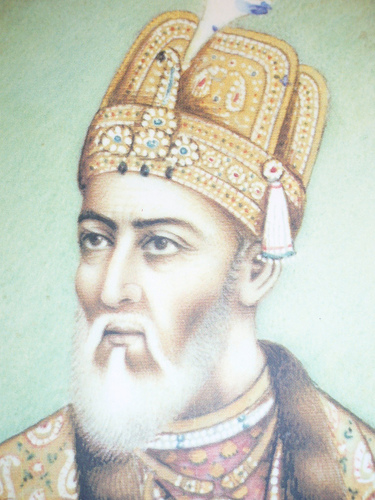Bahadur Shah Zafar and Hazrat Mahal- Devotees of Imam Husain in Exile?
By Prof.Mazhar Naqvi


Bahadur Shah Zafar and Begum Hazrat Mahal, two great
devotees of Imam Husain and frontline leaders of India’s First war of
Independence remain buried in foreign lands. It is indeed unfortunate and
tragic. Both of them had tremendous affection for their homeland and they had
challenged the British supremacy to liberate India from their clutches. Bahadur
Shah had got a grave dug out for his burial at Mehrauli in New Delhi but he was
laid to rest in Burmese capital Yangon (Earlier known as Rangoon) where he was
asked to spend his last days in exile by the British.
On the other hand, Begum Hazrat Mahal who has proclaimed her
son Birjis Qadr as the king of Awadh after the outbreak of rebellion in 1857
remained elusive after the recapture of Lucknow. She took shelter in the Terai
area near Gorakhpur and finally settled at Kathmandu after coming to terms with
the Nepalese ruler. While occasionally talks about bringing the remains of Bahadur
shah Zafar erupts, no such demand has ever been made for Begum Hazrat Mahal.
To be honest, demand for brining back the remains of another
devotee of Imam Husain and queen mother of Nawab Wajid Ali Shah, Malika Kishwar
and her younger son General Hashmat should also be raised. They lie buried in Paris
following their death on way back to India after unsuccessfully trying to get
back their annexed kingdom. No doubt, they did not take part in the campaign
against British in 1857 as they were in London. But had Malika Kishwar been in India,
she should have surely been with the side of Hazrat Mahal. She was a lady of great
determination and courage. She had never stepped out of her purdah but did not
hesitate in proceeding to England for taking up the cause of her dethroned son.
Bahadur Shah was not from Imamia faith but he had great reverence
of Imam Husain. He used to offer prayers at Panja Sharif in Delhi for the
simple reason that it contained the imprints of hands of Maula Ali. The King preferred
to reach Panja Sharif by walking from Red Fort. During Muharram, the king
always wore green clothes. On 6th of Muharram, he took round of the
palace with a silver chain tied around his waist. He used to act as Faqir of
Hazrat Qasim on 7th day of Ashra. On 8th of Muharram, he
used to distribute water as Saqqa of Hazrat Abbas. On 10th of
Muharram, he used to offer prayers at Moti Masjid of Red Fort and eat after the
burial of tazias. He himself offered ‘nazr’ at the carefully laid ‘dastarkhwan’
in memory of martyrs of Karbala.
His love for Imam Husain and his companions have found detailed
description in an article written by
Maulvi Ameer Ahmad for a magazine ‘Shamae- Mazar ’ published in 1927.The King
had also exhibited his profound love for Hazrat Ali in one of his poems. He
says :
“
Mera hami hai Peshwa hai Ali
Mere
Har dard Ki dawa Hai Ali
Jo
Ho Husain Ka dushman Use Kahan Aman
Agar
Cha Padhta Bhi ho Who Barai Namo Naman
Namz
padh Ke sada sajdao qayam Ke saath
Wazifa
Chahiye Zikro Gham Imam Ke saath
Aap
samjhe Ya Na samjhein par zafar Hai aapka
Aaeye
Ab To Madad Ke Waste Bahre Khuda
Ya
Hussain Ibne Ali Banda bahut Nachaar Hai”
“(Ali is my benefactor
and leader and he cures all my sufferings. An enemy of Husain can’t escape from
the wrath of God even if he offers prayers regularly. It is a prerequisite for
a true Namaz to include the sacred memory of Imam in addition to Sajda and Qayam.
O Imam Zafar is truly your servant and seeks your help as he too feeble now)”
Similarly in her most trying days, Begum Hazrat Mahal did
not forget to erect an Imambara in Kathmandu. She was devoid of funds as the
ruler of Nepal had realized large sums and jewels from here to allow her to
remain in his country. But whatever was left over, the warrior queen spent on
construction of imambara and a mosque adjacent to it. When
she died in Nepal on April 7, 1879 she was buried in the Imambara in accordance
with her will. After Pandit Nehru, no Indian leader took interest even in
ensuring protection to her imambara and grave. As an outcome of indifference,
her imambara was demolished and replaced by a market. The mosque exists but
nobody knows that it was built by Hazrat Mahal. Even her grave is in open and can’t
be considered in a good condition. In Paris too, Malika Kishwar and General
Hashmat buried close to each other with no one to light even a candle on their
graves. Even officials and staff of Indian embassy don’t know anything about
the ill-fated queen mother and her son.
The apathy of the government is mainly because of the
indifference of Indian people to cherish and preserve the memory of those who
laid down their lives for their freedom. Lucky are those freedom fighters that
are remembered on the occasion of their birth and death anniversaries but
majority of them remaining unsung heroes and heroines. It is high time that
steps are taken to bring their remains of Zafar and Hazrat Mahal at least to India
so the future generations have the opportunity to emulate their deeds for a
free and secular India. How long will their exile continue?( Reference available
on request)
